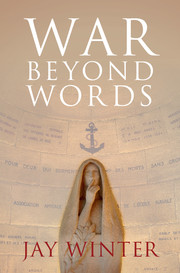Jay Winter is Charles J Stille Professor of History Emeritus at Yale University. His book War Beyond Words is an exposition in the ways the different creative arts have framed our thoughts on war from 1914 to the present.

Hardback 320pp RRP: $39.95
War Beyond Words is not your standard military history text or a study in the machinations of war and conflict. Winter reveals the ways in which the creative arts from painting and sculpture to photography, film and poetry impact on our memory and understanding of war and conflict.
In his introduction, Winter states that … ”I want to explore some well known and widely disseminated work of art to suggest the way contemporary artists today (2017) see war is very different from the way they saw it a century ago.”
The book is in two parts: Part 1: Vectors of Memory, in which Winter discusses the impact on our understanding through photography, film and writing. He comments upon the significance of the pocket camera in 1914 that enabled the common soldier to record the horrors around them. The role of the official photographers and censors was made so much more difficult, especially when newspaper editors encouraged soldiers to submit their photos. He comments on the work of photographers such as the Australian Frank Hurley to create composite photographs and sold as genuine images.
In the chapter on filming war and conflict, Winter highlights the influence of seminal films such as All Quiet on the Western Front, A Farewell to Arms, Catch 22, Paths of Glory and Blackhawk Down.
Part 11: Frameworks of Memory discusses the significance of Martyrdom with reference to the Holocaust. Winter examines the place in our culture for war memorials and military cemeteries. He discusses the significance of sculpture and iconography.
Winter describes the design and realisation of the Vietnam Veterans Memorial on the Mall in Washington DC. He also highlights the cascade of ceramic red poppies that emerged from the Tower of London in 2014, 888,246 poppies to commemorate the lives lost during World War One.
The book is very well illustrated with two sections of colour and black and white photographs reproduced on high quality gloss paper. These illustrations are a study in their own right and underline the theme of the book.
I found the book a difficult read at first, until I came to terms with its rather esoteric content. It has prompted me to reflect much more on the images and iconography of our own military experiences, including buildings such as the Shrine of Remembrance, the military cemetery at Springvale, and the sculptures in the Domain including Blamey, Monash, and Weary Dunlop.
Reading the book has allowed me to put into context, structures such as the POW Memorial at Ballarat and the Police Memorial in Birdwood Avenue.
The book helped me put into context the work of filmmakers such as Damien Parer and Peter Weir, and war artists such as Ivor Hele. It also clarifies and supports the cost, time and effort devoted to the recording of Australians at war by creative artists and writers over the past one hundred years.
It is not a book for the average reader of military history. Winter’s book is a major contribution to our understanding of the diverse ways in which men and women have wrestled with the intractable task of conveying what twentieth century wars mean to them and mean to us.
Reviewed for RUSIV by John Coulson, January 2018
Contact Royal United Services Institute about this article.






